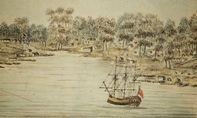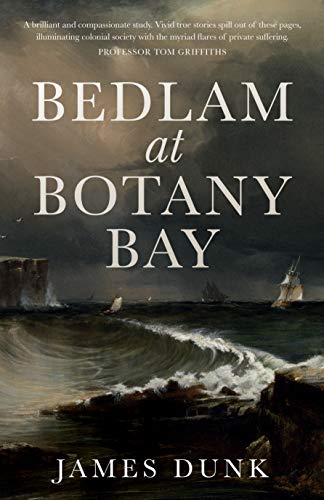- About Us
- Columns
- Letters
- Cartoons
- The Udder Limits
- Archives
- Ezy Reading Archive
- 2024 Cud Archives
- 2023 Cud Archives
- 2022 Cud Archives
- 2021 Cud Archives
- 2020 Cud Archives
- 2015-2019
- 2010-2014
- 2004-2009
 |
(Feb 2020) On 'Bedlam at Botany Bay' by James Dunk |
Bedlam at Botany Bay, James Dunk, 2019. New South Books, Sydney
Bedlam is infamous as a place of madness in England. Its name has become a shorthand for chaos and irrationality in human behaviour. James Dunk has taken the general theme of mental illness and very astutely examined how the nascent social and political institutions of New South Wales attempted to define and respond to mental illness in the penal colony.
When historians follow a theme such as Dunk has done, they produce fresh hypotheses about the documents of the past. The background to debates and conflicts over policy on mental illness lies in the tension between conflicting images of the future of New South Wales. The colony established in 1788 was most obviously a place of punishment run by the English state. As a dumping ground for convicts it was seen by colonial administrators as necessarily authoritarian. As the numbers of free settlers increased however, politicians began to countenance the possibility that a civil society might develop. Demands for responsible government grew louder as the needs of free settlers clashed with the dictatorial attitudes of governors.
Dunk produces ample evidence of these tensions in the usual personalities. Names such as Macquarie, Macarthur, Wentworth and Bligh are household names today and the clashes between their respective views of the colony have produced millions of words in explanation. Emancipation and the possibility of rehabilitation were seen as threats to vested interests.
Dunk also highlights some lesser known biographies which shed light specifically on attitudes to mental illness and more generally on these ongoing tensions and debates over the emerging society. He follows in some detail the fortunes of John Grant, who seemed to be always on the edge of madness. Grant ran foul of English law when his passion for a woman was frustrated by her preference for another. So passion played a role in Grant’s mad behaviour. So too did his transportation. He expressed the opinion that exile was itself his punishment and that further restrictions on his liberty were unfair. He blamed the system for his bankruptcy and pursued his rights in what was regarded by the authorities as an obsessive manner. Dunk also notes that convicts awaiting execution or transportation were sometimes made unbalanced by the experience.
The perception of madness was complicated by the determination of some convicts to escape their fates by feigning madness. From the earliest times, Governors had the final say on the state of a person’s mind, but competing authorities were claiming some role in the process. Medical and legal professionals were relevant in this area. The confused relative positions of these sources of power were illustrated in the case of the Castle Hill asylum, where George Suttor was superintendent. Most such institutions were closed places and differed little from prisons.
From the earliest times, Governors had the final say on the state of a person’s mind, but competing authorities were claiming some role in the process. Medical and legal professionals were relevant in this area. The confused relative positions of these sources of power were illustrated in the case of the Castle Hill asylum, where George Suttor was superintendent. Most such institutions were closed places and differed little from prisons.
Dunk has unearthed numerous cases of mental illness and has analysed their causes well. The quality of his research lies in the way that he continually places the state’s response in the foreground. The sheer scale of madness is undeniable and its relation to confusion over the colony’s identity is now clear. He notes for example that among the Rum Rebellion conspirators, three were declared mad and another suicided. Dunk does not avoid the question of whether declarations of madness were made for political expedience.
Another characteristic of good history writing is that it shows itself relevant to current circumstances. There is no doubt that Dunk’s examination of the origins of mental health treatment in Australia help to explain why the system still treats the mentally ill as though they are criminals. Dunk also notes that trauma threatens mental stability. Perhaps the greatest trauma of all was inflicted on the dispossessed Indigenous peoples whose lives were threatened. Violence was physical but also cultural as people lost the bases of their identities. Madness in Australia makes sufferers into fringe dwellers. Dunk concludes that ‘to write and read history may be therapeutic’. It does need to be read however with an open mind free of a white blindfold or any prejudice against people who differ from the norm.
Dr Tony Smith is a former political science academic. His writings appear occasionally on Pearls and Irritations.
